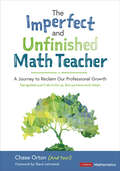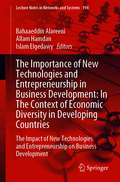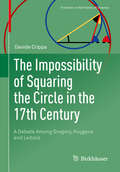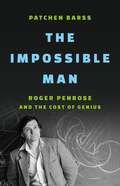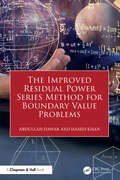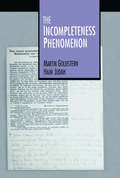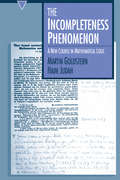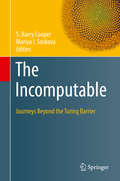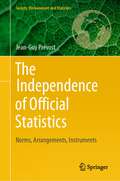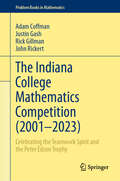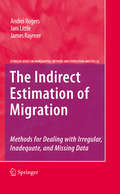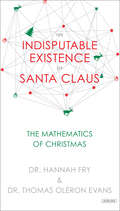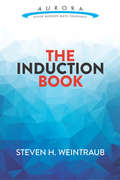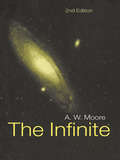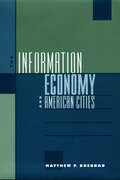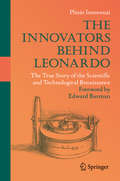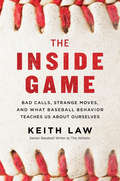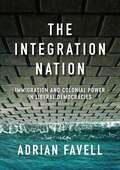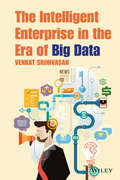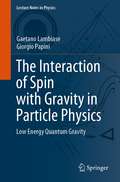- Table View
- List View
The Imperfect and Unfinished Math Teacher [Grades K-12]: A Journey to Reclaim Our Professional Growth (Corwin Mathematics Series)
by Chase OrtonThe system won’t do it for us. But we have each other. In The Imperfect and Unfinished Math Teacher: A Journey to Reclaim Our Professional Growth, master storyteller Chase Orton offers a vulnerable and courageous grassroots guide that leads K-12 math teachers through a journey to cultivate a more equitable, inclusive, and cohesive culture of professionalism for themselves…what he calls professional flourishment. The book builds from two bold premises. First, that as educators, we are all naturally imperfect and unfinished, and growth should be our constant goal. Second, that the last 40 years of top-down PD efforts in mathematics have rarely supplied teachers with what they need to equitably grow their practice and foster classrooms that are likewise empowered, inclusive, and cohesive. With gentle humanity, this book inspires teachers to break down silos, observe each others’ classrooms, interrogate their own biases, and put students at the center of everything they do in the math classroom. This book: Weaves raw and authentic stories—both personal and those from other educators—into a relatable and validating narrative Offers interactive opportunities to self-reflect, build relationships, seek new vantage on our teaching by observing others’ classrooms and students, and share and listen to other’s stories and experiences Asks teachers to give and accept grace as they work collaboratively to better themselves and the system from within, so that they can truly serve each of their students authentically and equitably Implementing the beliefs and actions in this book will position teachers to become more active partners in each other’s professional growth so that they can navigate the obstacles in their professional landscape with renewed focus and a greater sense of individual and collective efficacy. It equips teachers—and by extension, their students—to chart their own course and author their own equitable and joyful mathematical and professional stories.
The Importance of New Technologies and Entrepreneurship in Business Development: The Impact of New Technologies and Entrepreneurship on Business Development (Lecture Notes in Networks and Systems #194)
by Islam Elgedawy Allam Hamdan Bahaaeddin AlareeniThis book introduces the students, researchers and practitioners into the subject and enabling technologies and applications pertaining to of technology, entrepreneurship and business development through research articles, case studies etc. It is primarily intended for academic purposes for learners of computer Science, management, accounting and information systems disciplines, economics,- entrepreneurship. Publishing chapters in the book is new innovative idea to spread the book in the Middle East and Arab countries and make the book achieve more sales. As many students in all levels, graduates and undergraduates in addition to research, professionals are not able to get sufficient resources because of the language concern.
The Impossibility of Squaring the Circle in the 17th Century: A Debate Among Gregory, Huygens and Leibniz (Frontiers in the History of Science)
by Davide CrippaThis book is about James Gregory’s attempt to prove that the quadrature of the circle, the ellipse and the hyperbola cannot be found algebraically. Additonally, the subsequent debates that ensued between Gregory, Christiaan Huygens and G.W. Leibniz are presented and analyzed. These debates eventually culminated with the impossibility result that Leibniz appended to his unpublished treatise on the arithmetical quadrature of the circle. The author shows how the controversy around the possibility of solving the quadrature of the circle by certain means (algebraic curves) pointed to metamathematical issues, particularly to the completeness of algebra with respect to geometry. In other words, the question underlying the debate on the solvability of the circle-squaring problem may be thus phrased: can finite polynomial equations describe any geometrical quantity? As the study reveals, this question was central in the early days of calculus, when transcendental quantities and operations entered the stage. Undergraduate and graduate students in the history of science, in philosophy and in mathematics will find this book appealing as well as mathematicians and historians with broad interests in the history of mathematics.
The Impossible Man: Roger Penrose and the Cost of Genius
by Patchen BarssA "beautifully composed and revealing" (Financial Times) biography of the dazzling and painful life of Nobel Prize–winning physicist Roger Penrose—"a stunning achievement" (Kai Bird, American Prometheus). When he was six years old, Roger Penrose discovered a sundial in a clearing near his house. Through that machine made of light, shadow, and time, Roger glimpsed a &“world behind the world&” of transcendently beautiful geometry. It spurred him on a journey to become one of the world&’s most influential mathematicians, philosophers, and physicists. Penrose would prove the limitations of general relativity, set a new agenda for theoretical physics, and astound colleagues and admirers with the elegance and beauty of his discoveries. However, as Patchen Barss documents in The Impossible Man, success came at a price: He was attuned to the secrets of the universe, but struggled to connect with loved ones, especially the women who care for or worked with him. Both erudite and poetic, The Impossible Man draws on years of research and interviews, as well as previously unopened archives to present a moving portrait of Penrose the Nobel Prize-winning scientist and Roger the human being. It reveals not just the extraordinary life of Roger Penrose, but asks who gets to be a genius, and who makes the sacrifices that allow one man to be one.
The Improved Residual Power Series Method for Boundary Value Problems
by Abdullah Dawar Hamid KhanThis book introduces a semi- analytical method, Improved Residual Power Series Method (IRPSM), for solving boundary value problems (BVPs). Unlike traditional numerical and analytical techniques, IRPSM offers quick convergence and minimal computational time, avoiding the pitfalls of round- off errors, linearization, perturbation, and discretization. This innovative approach has been rigorously compared with existing methods, demonstrating superior accuracy and efficiency. The book is meant for scholars, researchers, and students in mathematics, engineering, and physics. This book: Explores the application of IRPSM to a wide range of problems, including ordinary and partial differential equations, multi- point BVPs, and complex systems in physics and engineering Highlights IRPSM for its ability to efficiently handle highly nonlinear and complex boundary value problems, providing accurate solutions with reduced computational effort Demonstrates the method’s applicability across disciplines such as fluid dynamics and engineering Provides Mathematica codes for each solved problem, allowing readers to understand the solution procedure and implement IRPSM in their own research Offers a new and efficient method for solving BVPs and a practical reference for those seeking to minimize computational time and error in their work.
The Incompleteness Phenomenon
by Martin Goldstern Haim JudahThis introduction to mathematical logic takes Gödel's incompleteness theorem as a starting point. It goes beyond a standard text book and should interest everyone from mathematicians to philosophers and general readers who wish to understand the foundations and limitations of modern mathematics.
The Incompleteness Phenomenon
by Martin Goldstern Haim JudahThe authors have written an introduction to logic taking Godel's incompleteness theorem as a starting point. The book should interest everyone from mathematicians to philosophers and readers who wish to understand the foundations and limitations of rational thinking. It is used as a textbook at major colleges and universities but lends itself to self-study as well.
The Incomputable
by S. Barry Cooper Mariya I. SoskovaThis book questions the relevance of computation to the physical universe. Our theories deliver computational descriptions, but the gaps and discontinuities in our grasp suggest a need for continued discourse between researchers from different disciplines, and this book is unique in its focus on the mathematical theory of incomputability and its relevance for the real world. The core of the book consists of thirteen chapters in five parts on extended models of computation; the search for natural examples of incomputable objects; mind, matter, and computation; the nature of information, complexity, and randomness; and the mathematics of emergence and morphogenesis. This book will be of interest to researchers in the areas of theoretical computer science, mathematical logic, and philosophy.
The Independence of Official Statistics: Norms, Arrangements, Instruments (Society, Environment and Statistics)
by Jean-Guy PrévostThis book explores the independence of official statistics and describes the various legal and professional norms, institutional arrangements, instruments and practices that statisticians have developed over recent decades to protect their work from political interference. It argues that this ‘drive for independence’, which saw the replication of these norms, arrangements, and instruments across countries, was largely led by the international epistemic community of statisticians, and it identifies some of the paths and processes that enabled this drive.The study conducts an overall, multi-dimensional, and detailed comparative examination of the thirty-eight OECD countries’ norms, arrangements, and practices regarding the institutional and professional independence of official statistics. For that purpose, several dimensions have been surveyed and an index has been built that allows patterns and clusters to be uncovered among the OECD countries, shedding light on the variations that can be observed from one subgroup of countries to another.The issue of the independence of official statistics has been at the heart of several recent statistical controversies, including that of Greece’s debt, censuses in Canada and the United States, the Argentinian cost of living index, and some recent cases of resignation or dismissal of senior statisticians in various countries. Such independence has been a major topic of discussion in the epistemic community since the turn of the century, and concerns have also been addressed more widely, in the media. The subject of the book is particularly relevant as official statistics also play a significant role in monitoring the progress of the United Nations’ Sustainable Development Goals. This book will appeal to anyone interested in the topic of official statistics and to students of government in general.
The Indiana College Mathematics Competition: Celebrating the Teamwork Spirit and the Peter Edson Trophy (Problem Books in Mathematics)
by Adam Coffman Justin Gash Rick Gillman John RickertThis book gathers problems based on over twenty years of the Indiana College Mathematics Competition, a regional problem-solving contest for teams of undergraduates. Its problems and solutions are accessible to students in a standard college curriculum, not necessarily with Olympiad-level training. Problem sets form the core of Part I, covering myriad aspects of algebra, calculus, number theory, probability, and geometry. Chapters are organized by year, and an index allows easy navigation through specific topics. In Part II, the reader finds detailed solutions to the exercises. With revised solutions designed for a didactical approach, this book can be especially useful as a resource for problem-solving courses in college mathematics or as practice problems for graduate entrance exams. This volume is a sequel to Rick Gillman's "A Friendly Competition," which documented the first 35 years of the competition.
The Indirect Estimation of Migration
by Jani Little Andrei Rogers James RaymerThis unique book introduces an essential element in applied demographic analysis: a tool-kit for describing, smoothing, repairing and - in instances of totally missing data - inferring directional migration flows. Migration rates combine with fertility and mortality rates to shape the evolution of human populations. Demographers have found that all three generally exhibit persistent regularities in their age and spatial patterns, when changing levels are controlled for. Drawing on statistical descriptions of such regularities, it is often possible to improve the quality of the available data by smoothing irregular data, imposing the structures of borrowed and related data on unreliable data, and estimating missing data by indirect methods. Model migration schedules and log-linear models are presented as powerful methods for helping population researchers, historical demographers, geographers, and migration analysts work with the data available to them.
The Indisputable Existence of Santa Claus: The Mathematics of Christmas
by Thomas Oléron Evans Dr. Hannah FryTwo merry mathematicians explore the geometry of gift-wrapping, board game theory, and much more in this hilarious holiday treat.How do you apply game theory to select who should be on your Christmas shopping list? What equations should you use to decorate the Christmas tree? Will calculations show Santa is getting steadily thinner—shimmying up and down chimneys for a whole night—or fatter—as he munches on cookies and milk in billions of houses across the world?In The Indisputable Existence of Santa Claus, distinguished mathematicians Hannah Fry and Thomas Oléron Evans demonstrate, with eminently readable clarity, how applied mathematics are so thoroughly interwoven throughout our everyday lives by explaining mathematical concepts through one very merry motif: Christmas. In their quest to provide mathematical proof for the existence of Santa, the authors take readers on a festive journey through a traditional holiday season, wherein every activity, from wrapping presents to playing board games to cooking the perfect turkey, is painstakingly and hilariously analyzed. Because who hasn’t always wondered how to set up a mathematically perfect Secret Santa? Lighthearted and diverting with Christmasy diagrams, sketches and graphs, equations, Markov chains, and matrices, The Indisputable Existence of Santa Claus brightens up the bleak midwinter with a stockingful of mathematical marvels.
The Indo-European Controversy
by Martin W. Lewis Asya Pereltsvaig Pereltsvaig, Asya and Lewis, Martin W.Over the past decade, a group of prolific and innovative evolutionary biologists has sought to reinvent historical linguistics through the use of phylogenetic and phylogeographical analysis, treating cognates like genes and conceptualizing the spread of languages in terms of the diffusion of viruses. Using these techniques, researchers claim to have located the origin of the Indo-European language family in Neolithic Anatolia, challenging the near-consensus view that it emerged in the grasslands north of the Black Sea thousands of years later. But despite its widespread celebration in the global media, this new approach fails to withstand scrutiny. As languages do not evolve like biological species and do not spread like viruses, the model produces incoherent results, contradicted by the empirical record at every turn. This book asserts that the origin and spread of languages must be examined primarily through the time-tested techniques of linguistic analysis, rather than those of evolutionary biology.
The Induction Book
by Steven H. WeintraubMathematical induction — along with its equivalents, complete induction and well-ordering, and its immediate consequence, the pigeonhole principle — constitute essential proof techniques. Every mathematician is familiar with mathematical induction, and every student of mathematics requires a grasp of its concepts. This volume provides an introduction and a thorough exposure to these proof techniques. Geared toward students of mathematics at all levels, the text is particularly suitable for courses in mathematical induction, theorem-proving, and problem-solving. The treatment begins with both intuitive and formal explanations of mathematical induction and its equivalents. The next chapter presents many problems consisting of results to be proved by induction, with solutions omitted to enable instructors to assign them to students. Problems vary in difficulty; the majority of them require little background, and the most advanced involve calculus or linear algebra. The final chapter features proofs too complicated for students to find on their own, some of which are famous theorems by well-known mathematicians. For these beautiful and important theorems, the author provides expositions and proofs. The text concludes with a helpful Appendix providing the logical equivalence of the various forms of induction.
The Infinite
by A. W. MooreAnyone who has pondered the limitlessness of space and time, or the endlessness of numbers, or the perfection of God will recognize the special fascination of this question. Adrian Moore's historical study of the infinite covers all its aspects, from the mathematical to the mystical.
The Infinite Desire for Growth
by Daniel Cohen Jane ToddWhy society’s expectation of economic growth is no longer realisticEconomic growth--and the hope of better things to come—is the religion of the modern world. Yet its prospects have become bleak, with crashes following booms in an endless cycle. In the United States, eighty percent of the population has seen no increase in purchasing power over the last thirty years and the situation is not much better elsewhere. The Infinite Desire for Growth spotlights the obsession with wanting more, and the global tensions that have arisen as a result. Amid finite resources, increasing populations, environmental degradation, and political unrest, the quest for new social and individual goals has never been so critical.Leading economist Daniel Cohen provides a whirlwind tour of the history of economic growth, from the early days of civilization to modern times, underscoring what is so unsettling today. The new digital economy is establishing a "zero-cost" production model, inexpensive software is taking over basic tasks, and years of exploiting the natural world have begun to backfire with deadly consequences. Working hard no longer guarantees social inclusion or income. Drawing on economics, anthropology, and psychology, and thinkers ranging from Rousseau to Keynes and Easterlin, Cohen examines how a future less dependent on material gain might be considered and, how, in a culture of competition, individual desires might be better attuned to the greater needs of society.At a time when wanting what we haven't got has become an obsession, The Infinite Desire for Growth explores the ways we might reinvent, for the twenty-first century, the old ideal of social progress.
The Influence of Demographic Stochasticity on Population Dynamics
by Tommaso BiancalaniThe dynamics of population systems cannot be understood within the framework of ordinary differential equations, which assume that the number of interacting agents is infinite. With recent advances in ecology, biochemistry and genetics it is becoming increasingly clear that real systems are in fact subject to a great deal of noise. Relevant examples include social insects competing for resources, molecules undergoing chemical reactions in a cell and a pool of genomes subject to evolution. When the population size is small, novel macroscopic phenomena can arise, which can be analyzed using the theory of stochastic processes. This thesis is centered on two unsolved problems in population dynamics: the symmetry breaking observed in foraging populations and the robustness of spatial patterns. We argue that these problems can be resolved with the help of two novel concepts: noise-induced bistable states and stochastic patterns.
The Information Economy and American Cities
by Matthew P. DrennanData on how cities have adapted to changing times: &“An excellent analysis of the rise and role of the information sector . . . in regional economic development.&” — Regional Science and Urban Economics How do metropolitan regions remain prosperous and competitive in a rapidly changing economy? Using hard data, Matthew Drennan shows that those regions that have invested heavily in the information economy have done much better than those that continue to rely on manufacturing and industry as their base. Moreover, he contends, the benefits of that growth reach the urban working poor, earlier reports to the contrary notwithstanding. The Information Economy and American Cities provides a wealth of rigorously analyzed econometric data of great value to economists, planners, and policymakers concerned with the future of America&’s metropolitan areas, and provides the kind of hard evidence needed to advocate effectively for change.</
The Information Theory of Comparisons: With Applications to Statistics and the Social Sciences
by Roger BowdenThis book finds a broad domain of relevance in statistics and the social sciences. Its conceptual development is supported by applications to economics and income distribution, finance, education, demographics and actuarial science, political studies, psychology, and general statistics. Fresh perspectives on directional complexity have generated an informational theory of ‘more versus less’, with representative polar outcomes as good or bad, or rich or poor. New duality metrics for spread and asymmetry have resulted, motivated by internal perspectives on the part of subjects, such as attitudes to their comparative (dis)advantage. This book is a readable review of these developments. Concepts and applications are described in tandem with each other. They consolidate recent contributions to the research literature, augmented with fresh insights and applications. Dynamic extensions include modeling shifting social attitudes, while the broader agenda encompasses topical areas such as subjectivist probability, investment decision making, and income distribution.
The Inner Workings of Life
by Eberhard O. VoitLiving systems are dynamic and extremely complex and their behaviour is often hard to predict by studying their individual parts. Systems biology promises to reveal and analyse these highly connected, regulated and adaptable systems, using mathematical modelling and computational analysis. This new systems approach is already having a broad impact on biological research and has potentially far-reaching implications for our understanding of life. Written in an informal and non-technical style, this book provides an accessible introduction to systems biology. Self-contained vignettes each convey a key theme and are intended to enlighten, provoke and interest readers of different academic disciplines, but also to offer new insight to those working in the field. Using a minimum amount of jargon and no mathematics, Voit manages to convey complex ideas and give the reader a genuine sense of the excitement that systems biology brings with it, as well as the current challenges and opportunities.
The Innovators Behind Leonardo: The True Story of the Scientific and Technological Renaissance
by Plinio InnocenziThis engaging book places Leonardo da Vinci’s scientific achievements within the wider context of the rapid development that occurred during the Renaissance. It demonstrates how his contributions were not in fact born of isolated genius, but rather part of a rich period of collective advancement in science and technology, which began at least 50 years prior to his birth.Readers will discover a very special moment in history, when creativity and imagination were changing the future—shaping our present. They will be amazed to discover how many technological inventions had already been conceived or even designed by the engineers and inventors who preceded Leonardo, such as Francesco di Giorgio and Taccola, the so-called Siena engineers. This engaging volume features a wealth of illustrations from a variety of original sources, such as manuscripts and codices, enabling the reader to see and judge for him or herself the influence that other Renaissance engineers and inventors had on Leonardo.
The Inside Game: Bad Calls, Strange Moves, and What Baseball Behavior Teaches Us About Ourselves
by Keith LawIn this groundbreaking book, Keith Law, baseball writer for The Athletic and author of the acclaimed Smart Baseball, offers an era-spanning dissection of some of the best and worst decisions in modern baseball, explaining what motivated them, what can be learned from them, and how their legacy has shaped the game.For years, Daniel Kahneman’s iconic work of behavioral science Thinking Fast and Slow has been required reading in front offices across Major League Baseball. In this smart, incisive, and eye-opening book, Keith Law applies Kahneman’s ideas about decision making to the game itself.Baseball is a sport of decisions. Some are so small and routine they become the building blocks of the game itself—what pitch to throw or when to swing away. Others are so huge they dictate the future of franchises—when to make a strategic trade for a chance to win now, or when to offer a millions and a multi-year contract for a twenty-eight-year-old star. These decisions have long shaped the behavior of players, managers, and entire franchises. But as those choices have become more complex and data-driven, knowing what’s behind them has become key to understanding the sport. This fascinating, revelatory work explores as never before the essential question: What were they thinking?Combining behavioral science and interviews with executives, managers, and players, Keith Law analyzes baseball’s biggest decision making successes and failures, looking at how gambles and calculated risks of all sizes and scales have shaped the sport, and how the game’s ongoing data revolution is rewriting decades of accepted decision making. In the process, he explores questions that have long been debated, from whether throwing harder really increases a player’s risk of serious injury to whether teams actually “overvalue” trade prospects.Bringing his analytical and combative style to some of baseball’s longest running debates, Law deepens our knowledge of the sport in this entertaining work that is both fun and deeply informative.
The Integration Nation: Immigration and Colonial Power in Liberal Democracies (Immigration and Society)
by Adrian FavellThe notion of ‘immigrant integration’ is used everywhere – by politicians, policy makers, journalists and researchers – as an all-encompassing framework for rebuilding ‘unity from diversity’ after large-scale immigration. Promising a progressive middle way between backward-looking ideas of assimilation and the alleged fragmentation of multiculturalism, ‘integration’ has become the default concept for states scrambling to deal with global refugee management and the persistence of racial disadvantage. Yet ‘integration’ is the continuance of a long-standing colonial development paradigm. It is how majority-white liberal democracies absorb and benefit from mass migration while maintaining a hierarchy of race and nationality – and the global inequalities it sustains. Immigrant integration sits at the heart of the neo-liberal racial capitalism of recent decades, in which tight control of nation-building and bordering selectively enables some citizens to enjoy the mobilities of a globally integrating world, as other populations are left behind and locked out. Subjecting research and policy on immigrant integration to theoretical scrutiny, The Integration Nation offers a fundamental rethink of a core concept in migration, ethnic and racial studies in the light of the challenge posed by decolonial theory and movements.
The Intelligent Enterprise in the Era of Big Data
by Venkat SrinivasanAn innovative guide to the organization and function of enterprises in the technological age In the era of big data and automation, this book presents a cutting-edge approach in how enterprises should organize and function. Striking a practical balance between theory and practice, The Intelligent Enterprise in the Era of Big Data presents an enterprise architecture that embodies the power of the emerging technology environment. Beginning with an introduction to the key challenges that enterprises face, the book systematically outlines a modern enterprise architecture through a detailed discussion of the inseparable elements of such an architecture: efficiency, flexibility, and intelligence. This architecture enables rapid responses to market needs by facilitating intelligent, flexible automation of enterprise business processes and sensing important developments in internal and external environments in near real time. Illustrating all of these elements in an integrated fashion, The Intelligent Enterprise in the Era of Big Data also features: A detailed discussion on issues of time-to-market and flexibility with respect to enterprise application technology Novel analyses illustrated through extensive real-world case studies to help readers better understand the applicability of the architecture and concepts Practical approaches for designing and building intelligent enterprises An appendix that presents various approaches to text analysis with real-world business implications The Intelligent Enterprise in the Era of Big Data is an appropriate reference for business executives, information technology professionals, data scientists, and management consultants.
The Interaction of Spin with Gravity in Particle Physics: Low Energy Quantum Gravity (Lecture Notes in Physics #993)
by Gaetano Lambiase Giorgio PapiniThis book seeks to present a new way of thinking about the interaction of gravitational fields with quantum systems. Despite the massive amounts of research and experimentation, the myriad meetings, seminars and conferences, all of the articles, treatises and books, and the seemingly endless theorization, quantization and just plain speculation that have been engaged in regarding our evolving understanding of the quantum world, that world remains an enigma, even to the experts. The usefulness of general relativity in this regard has proven to be imperfect at best, but there is a new approach. We do not simply have to accept the limitations of Einstein's most celebrated theorem in regard to quantum theory; we can also embrace them, and thereby utilize them, to reveal new facts about the behavior of quantum systems within inertial and gravitational fields, and therefore about the very structure of space–time at the quantum level. By taking existing knowledge of the essential functionality of spin (along with the careful identification of the omnipresent inertial effects) and applying it to the quantum world, the book gives the reader a much clearer picture of the difference between the classical and quantum behaviors of a particle, shows that Einstein's ideas may not be as incompatible within this realm as many have come to believe, sparks new revelations of the way in which gravity affects quantum systems and brings a new level of efficiency—quantum efficiency, if you will—to the study of gravitational theory.
